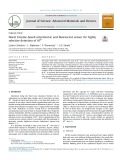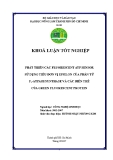
Fluorescent sensor
-
The complexation activity of NADO with various metal ions in an ethanolic solution is specifically studied by means of fluorescent spectra. The NADO exhibits a significant fluorescence enhancement at 469 nm in presence of Al3 þ due to the formation of a complex.
 8p
8p  tamynhan4
tamynhan4
 06-09-2020
06-09-2020
 10
10
 2
2
 Download
Download
-
Adenosine 5’-triphosphate (ATP) là hợp chất cao năng quan trọng nhất, giữ vai trò cung cấp năng lƣợng trong mọi tế bào sống. Bởi vì trong phân tử ATP có hai liên kết phosphate cao năng, năng lƣợng tự do sẽ đƣợc giải phóng khi ATP bị thủy phân thành Adenosine 5’-diphosphate (ADP) và một phosphate vô cơ (Pi), hoặc Adenosine monophosphate (AMP) và pyrophosphate (PPi). Do đó, phần lớn các hoạt động sống nhƣ vận chuyển, hấp thu dinh dƣỡng, sinh tổng hợp các chất, phân chia tế bào … đều sử dụng ATP nhƣ nguồn năng lƣợng trực...
 67p
67p  canhchuon_1
canhchuon_1
 19-06-2013
19-06-2013
 88
88
 11
11
 Download
Download
-
To measure mechanical stress in real time, we designed a fluorescence reso-nance energy transfer (FRET) cassette, denoted stFRET, which could be inserted into structural protein hosts. The probe was composed of a green fluorescence protein pair, Cerulean and Venus, linked with a stablea-helix.
 16p
16p  galaxyss3
galaxyss3
 07-03-2013
07-03-2013
 50
50
 6
6
 Download
Download
-
Lighting Controller 1. Dimming control of fluorescent lamps, mercury lamps and metal halide lamps. • More than 40% electric power saving compared with NO MERS systems. 2. Replace mercury lamp with metal halide lamp with MERS metal halide controller. • Approx. 40% electric power saving compared with NO MERS mercury lamp systems. (from Titech experiment) 3. Intelligent dimming control of lamps with MERS, sensors and Constraint Technology. • Significant saving can be expected compared with existing systems according to QOS....
 12p
12p  tvq_pro
tvq_pro
 03-11-2012
03-11-2012
 73
73
 10
10
 Download
Download
CHỦ ĐỀ BẠN MUỐN TÌM
















